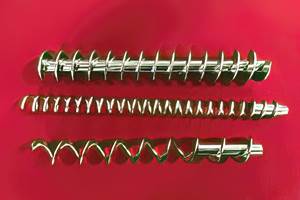EXTRUSION: Avoid General ‘Pump Ratios’ On Two-Stage Screws
Instead, rely on basic data and calculations to determine the proper depth of the first and second metering sections
Using a generalized “pump ratio” for the depth of the first and second metering sections of a two-stage screw can cause problems. There is no actual ratio that can be applied universally, just like there is no such thing as a “general-purpose” screw. Proper sizing of the second metering section can be accurately determined, but requires knowledge of the head pressure and polymer viscosity at the correct shear rate. The use of a single ratio simply cannot provide a good answer in most cases.
The output of the first stage of a two-stage screw can usually be closely approximated as being equal to the drag flow, since there is no head pressure due to the open vent. Sizing of the second stage then is a matter of calculating the drag flow of the second stage, subtracting the pressure flow, and using that data to determine the amount of fill in the second metering section. However, to calculate the pressure flow it’s imperative to have accurate data on the head pressure and viscosity.
Using a fixed ratio between the two metering sections can result in a number of problems. First, the second metering may not have the capacity to handle the output of the first metering, resulting in vent flow. Conversely, the second metering may have too much capacity and only be filled for a very short distance, resulting in unstable output.
Inadequate fill length will result in a continuous cyclic surge that does not respond to any operating adjustment except increasing the head pressure. Also, with the second metering only filled for a very short distance, there is a lot of open area in the screw that tends to eventually form degraded polymer, resulting in product contamination.
To illustrate this effect, I took a 2.5-in., 24 L/D two-stage screw design with a 1.5:1 pump ratio and substituted various pressures and viscosities to show the difficulty in using a fixed pump ratio. Condition A was estimated with 3000 psi head pressure, while Condition B was calculated with 1000 psi head pressure. Since the first stage was unchanged, the output and melt temperature entering the second stage were identical. The same viscosity was used in both cases.
In Condition A the second pump could not handle the output of the first metering and back-filled, flooding the vent. In Condition B the 1000 psi head pressure was inadequate to back-fill the metering far enough for stable output, which would lead to a constant cyclic surge. The same situation would occur if the viscosity in Condition B were three times that of Condition A. This would be typical of many operations that process post-consumer reclaim, which can vary by such large viscosity differences. Condition A would have a flooded vent again while Condition B would have inadequate back-fill for stable operation.
In neither of these cases was a “pump ratio” of 1.5:1 the correct design. Pump ratio is like compression ratio—a poor substitute for using actual data and basic calculations for the proper design to fit the individual operating conditions.
Related Content
What to Know About Your Materials When Choosing a Feeder
Feeder performance is crucial to operating extrusion and compounding lines. And consistent, reliable feeding depends in large part on selecting a feeder compatible with the materials and additives you intend to process. Follow these tips to analyze your feeder requirements.
Read MoreNPE2024 Wrap-Up: Sustainability Dominates Show Floor News
Across all process types, sustainability was a big theme at NPE2024. But there was plenty to see in automation and artificial intelligence as well.
Read MoreShredding Thin Film: How to Do It Right
While many processors recoil at this task, a little know-how in shredding equipment, processing, and maintenance should add the necessary confidence.
Read MoreHow to Select the Right Cooling Stack for Sheet
First, remember there is no universal cooling-roll stack. And be sure to take into account the specific heat of the polymer you are processing.
Read MoreRead Next
For PLASTICS' CEO Seaholm, NPE to Shine Light on Sustainability Successes
With advocacy, communication and sustainability as three main pillars, Seaholm leads a trade association to NPE that ‘is more active today than we have ever been.’
Read MorePeople 4.0 – How to Get Buy-In from Your Staff for Industry 4.0 Systems
Implementing a production monitoring system as the foundation of a ‘smart factory’ is about integrating people with new technology as much as it is about integrating machines and computers. Here are tips from a company that has gone through the process.
Read More.jpg;width=70;height=70;mode=crop)










